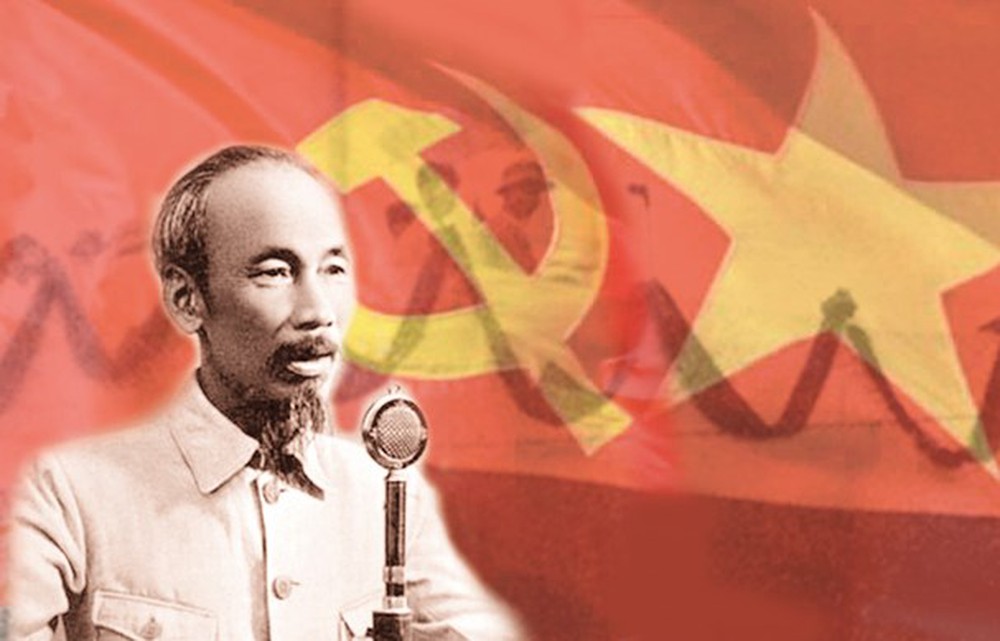
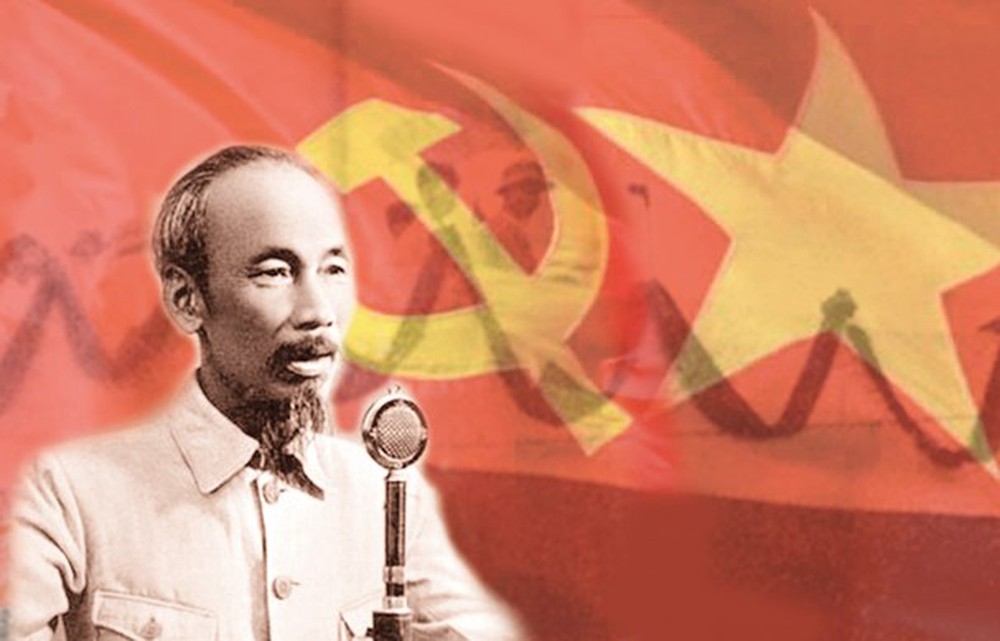
President Ho Chi Minh - revolutionary, founder of the Communist Party of Vietnam, one of the founders and leaders of the struggle for independence and territorial integrity for Vietnam in the 20th century, an international communist soldier
In the mid-nineteenth century, when capitalism began to move into the imperialist stage, their armies brought cannons to knock on the doors of the feudal countries of the East. From 1858, the French colonialists attacked Da Nang, starting the process of invading Vietnam. Nearly 30 years later, the Nguyen Dynasty kings and mandarins "allowed the French imperialists to trample on their heads", forcing them to sign the Harmand (1883) and Patenotre (1884) treaties, causing "more than twenty million compatriots to die in the circle of death".[1]. The dark clouds of colonialism covered the whole of Vietnam. The whole nation entered a harsh winter.
However, the more the domination, oppression and exploitation of the nation increased, the deeper the national contradiction with imperialism became, the more fierce and intense the struggle for national survival became, the more intense in nature, diverse in content and rich in form. With the spirit of "the first one falls, the next one stands up", the patriotic movements against the French took place continuously and heroically, but were all drowned in a sea of blood by the French imperialists.
The failure of the Can Vuong movement at the end of the 19th century demonstrated the inability of feudal ideology to solve the task of gaining national independence. At the beginning of the 20th century, the absorption of bourgeois democratic ideology from abroad poured into Vietnam, many patriots sacrificed themselves to save the country, but it was still unsuccessful, proving that the flag of bourgeois ideology was not capable of saving the Vietnamese people from slavery. The cause of national salvation fell into a "dark situation that seemed to have no way out".
In the context of "anti-imperialist revolutionary era, era of national liberation"[2]was opened from the October Revolution, after about 10 years of crossing the oceans, to many countries in the world, in both the East and the West, especially the developed capitalist countries (England, France, America); both studying theory and surveying practice; Nguyen Ai Quoc came to "First draft of theses on the national and colonial questions" of Lenin. He felt "moved, excited, enlightened, confident", and affirmed: "This is what we need! This is the path to liberation for us"[3]He affirmed the path of national salvation and liberation following the proletarian tendency, paving the way to resolve the crisis in the path of national salvation in the early 20th century.
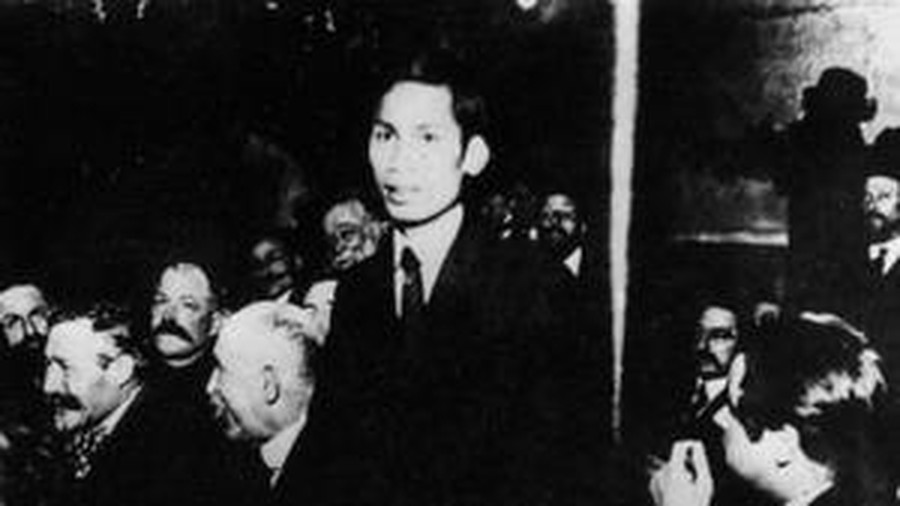
Nguyen Ai Quoc at the French Socialist Party Congress in 1920
Throughout the 1920s, Nguyen Ai Quoc persistently and persistently built and spread "National Liberation Theory”[4], and at the same time actively prepare the ideological, political and organizational conditions for the birth of a revolutionary political party in Vietnam.
Overcoming dogmatic stereotypes, with a spirit of independence, creativity and scientific courage, Nguyen Ai Quoc formulated a unique theory of revolution in the colonies, because "the venom and vitality of the capitalist snake are concentrated in the colonies", if he underestimated the revolution in the colonies, it means "wanting to kill the snake by the tail".[5].
Historical practice shows that in colonial countries "the class struggle does not take place as in the West... The conflict of their interests is minimized. That is undeniable."[6]. Originating from the main contradiction in the colonies, which is the contradiction between the oppressed nation and the invading imperialists and their lackeys, affirming that “the revolutionary nation has no class distinction”, Ho Chi Minh’s “Revolutionary Nation” doctrine strongly emphasized the struggle for national independence. The force of the “revolutionary nation” includes the entire nation, because “scholars, farmers, workers, and merchants are all united in opposing tyranny”, in which workers and farmers are the “revolutionary masters”, “revolutionary roots”, while students, small merchants, and small landowners are “revolutionary companions of workers and farmers”. The colonial revolution does not depend on the proletarian revolution in the mother country, but can win first, and while eliminating one of the conditions for the existence of imperialism, “they can help their brothers in the West in the task of complete liberation”.[7].
As the guiding flag of the Vietnamese national movement during the period of Party establishment, Ho Chi Minh's "National Revolution" doctrine became an ideological weapon for all classes of Vietnamese people, holding a decisive position in the political and ideological preparation for the birth of the Party and laying the foundation for building the Party's political platform later.
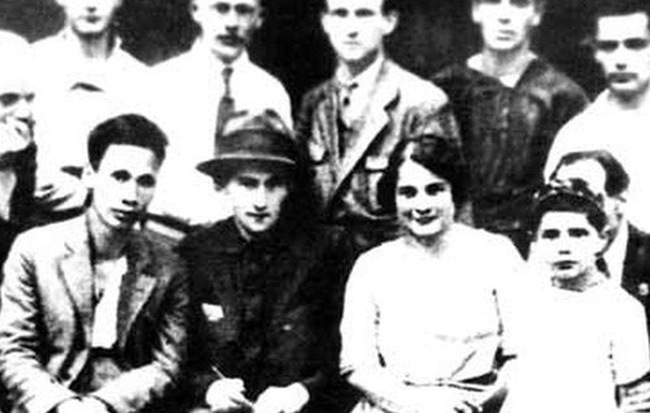
Nguyen Ai Quoc at the 5th Congress of the Communist International in the Soviet Union in 1924
Along with his political and ideological preparation, Nguyen Ai Quoc also actively prepared organizational conditions for the birth of a revolutionary party in Vietnam. At the end of 1924, he left the Soviet Union and returned to Guangzhou (China); he met with Vietnamese patriotic youth inHeart to heartand realized that they did not understand anything about theory, let alone organization. He chose a number of progressive young people and formed a group.Communist group(2-1925) was the nucleus for foundingVietnam Revolutionary Youth Association(June 1925). This was a patriotic organization with communist tendencies, a transitional step towards the establishment of the Communist Party, a decisive organizational preparation step for the later birth of the Party.
By 1929, the patriotic struggle movement of the Vietnamese people had developed strongly, requiring the leadership of a Communist Party. The role of the transitional organizations had come to an end in order to move forward to establish a higher organization. That requirement affectedVietnam Revolutionary Youth AssociationandTan Viet Revolutionary Party, leading to internal struggles and positive transformations within these organizations, forming three communist organizations in Vietnam:Indochinese Communist Party(6-1929),Annam Communist Party(8-1929) andIndochinese Communist Federation(September 1929). That proves that Ho Chi Minh's "National Revolution" doctrine has permeated deeply into the revolutionary struggle movement of the Vietnamese people, and the trend of establishing the Communist Party has become inevitable in Vietnam.
However, in a nation-state there were three communist organizations operating separately from each other, causing the forces and strength of the revolution to be dispersed. This was not in line with the interests of the revolutionary movement and the organizational principles of the Communist Party. It was urgent to end the factionalism between communist organizations and unify them into one party. But the communist organizations themselves could not unite due to the influence of localist and personalist ideas, which were the offspring of a backward and fragmented agricultural economy. The Indochinese Communist Party and the Annamese Communist Party “spent much - if not all - of their energy and time in internal and factional struggles”. “Both tried to unify each other, but the more they tried, the more they misunderstood each other and the wider the gap became.”[8]If this situation continues, it will be a danger to the Vietnamese revolutionary movement.
On October 18, 1929, the meeting of the Council of Secretaries of the Eastern Countries discussed the Draft Resolution on the establishment of the Indochinese Communist Party and the upcoming tasks of the Indochinese communists. On October 27, 1929, the Secretariat of the Eastern Countries completed the Draft Resolution with the title:On the establishment of a Communist Party in Indochina, stating that “The most important and urgent task of all communists in Indochina is to establish a revolutionary party of the class character of the proletariat, that is, a Communist Party of mass character in Indochina. That party must be only one and the only communist organization in Indochina.”[9].
On October 31, 1929, the above document was sent to the members of the Political Commission of the Communist International for review and comments on amendments "before the Political Secretariat adopted the official resolution."[10]. In December 1929, the Communist International passed a resolution. However,By the end of 1929, no communist in Indochina had received this resolution..
Before the Communist International passed its resolution in November 1929, Nguyen Ai Quoc was operating in Siam and trying to find a way back home, when a comrade from Hong Kong came to inform him about the “disintegration of the Revolutionary Youth Association of An Nam; the communists split into many factions”. He immediately left Siam for China and arrived there on December 23, 1929.
As a delegate of the Communist International, with full authority to decide on all issues related to the revolutionary movement in Indochina, he convened delegates of the two groups, the Indochinese Communist Party and the Annam Communist Party, to hold a Unification Conference in Kowloon (Hong Kong, China). The conference began on January 6, 1930.
Not only was Nguyen Ai Quoc a representative of the Communist International, he was also the founder of the Vietnam Revolutionary Youth Association and a teacher of patriotic youth in the early 20th century, so he had absolute prestige and led the Conference to success. After listening to Nguyen Ai Quoc talk about the mistakes of division and the task of establishing a Communist Party, the delegates all agreed to unify into one party called the Communist Party of Vietnam.
Not only did he play a decisive role in unifying the organization, Nguyen Ai Quoc was also the one who drafted the Party's first Political Platform and Statutes.First political platformThe task of national liberation, fighting against imperialism and its lackeys was emphasized in both political and economic aspects:politically, overthrow French imperialism and feudalism, make Vietnam completely independent, establish a worker-peasant-soldier government and organize a worker-peasant army;Economic, confiscated all large industries (such as industry, transportation, banking, etc.) of French imperialist capitalists to hand over to the worker-peasant-soldier government for management; confiscated all land of the imperialists as public property and distributed to poor peasants... While the policy of confiscating land was in the hands of the national enemy, the Platform raised the issue of "preparing for agrarian revolution and overthrowing the feudal landlords".[11]. The platform advocates rallying the entire nation's forces in the struggle for independence and freedom.
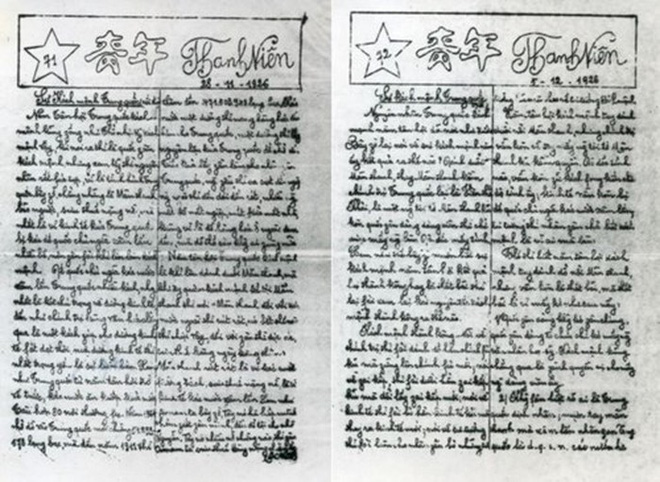
Thanh Nien Newspaper – Vietnam's first revolutionary newspaper
Combining the Marxist-Leninist theory of the Communist Party with the Vietnamese revolutionary practice, Ho Chi Minh built and propagated a doctrine of national liberation revolution among the Vietnamese people; solving the problem of national salvation path associated with preparing conditions in terms of political ideology and organization to found a revolutionary party, suitable to the Vietnamese practice, closely attached to the people, to the nation, wholeheartedly serving the Fatherland, serving the people, recognized by the people and the nation as its vanguard.
Right from the day of its founding, "Our Party immediately raised high the revolutionary flag, united and led all our people to fight for national liberation and class liberation. The Party's red flag shone brightly like the rising sun, tearing apart the darkness, illuminating the way for our people to firmly advance on the path of victory in the anti-imperialist and anti-feudal revolution."[12]“Although young and small, the Communist Party is the best organized and most active of all forces.”[13], gathering the strength of the entire nation. That is a characteristic and at the same time an advantage of the Party.
Spring 1930 - the spring of Party establishment, marked a great turning point in the development process of Vietnam's revolutionary history, ending the crisis of revolutionary leadership that lasted for several decades in the early 20th century. "The founding of the Party was an extremely important turning point in the history of our Vietnamese revolution. It proved that our proletariat had matured and was capable of leading the revolution."[14].
[1]Ho Chi MinhFull set, vol. 2, National Political Publishing House, Hanoi, 2000, p. 262.
[2]Ho Chi MinhFull set, vol. 8, National Political Publishing House, Hanoi, 2000, p. 563.
[3]Ho Chi MinhFull set, vol. 10, National Political Publishing House, Hanoi, 2000, p. 127.
[4]Tran Dan Tien:Stories about President Ho's life and work, Literature Publishing House, 1956, p. 71.
[5]Ho Chi Minh,Full set, vol. 1, National Political Publishing House, Hanoi, 2000, p. 273.
[6]Ho Chi Minh Complete Works, volume 2, National Political Publishing House, Hanoi, 2000, p. 464.
[7]Ho Chi MinhFull set, vol. 1, National Political Publishing House, Hanoi, 2000, p. 36.
[8]Communist Party of Vietnam:Complete Party Documents, vol. 2, National Political Publishing House, Hanoi, 1998, pp. 21 and 35.
[9]Communist Party of Vietnam:Complete Party Documents, vol. 1, National Political Publishing House, Hanoi, 1998, p. 614.
[10]Communist Party of Vietnam:Complete Party Documents, vol. 1, ibid., p. 621.
[11]Communist Party of Vietnam:Complete Party Documents, vol. 2, National Political Publishing House, Hanoi, 1998, p. 6.
[12]Ho Chi MinhFull set, vol. 10, ibid. p. 3.
[13]Communist Party of Vietnam:Complete Party Documents, vol. 2, ibid., p. 21.
[14]Ho Chi MinhFull set, vol. 10, ibid. p.8.
Author:Associate Professor, Dr. Vu Quang Hien